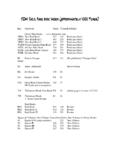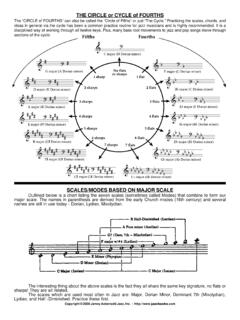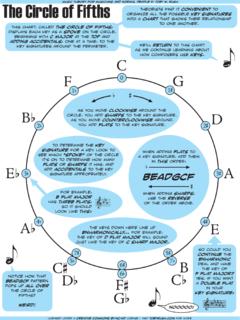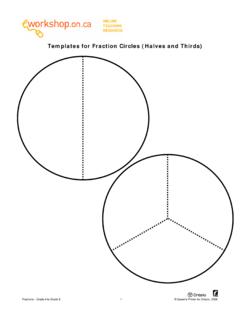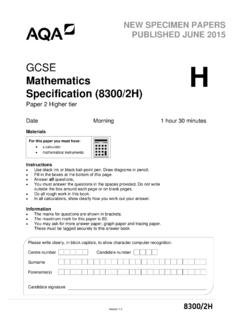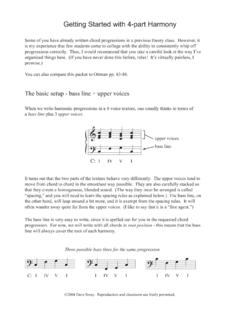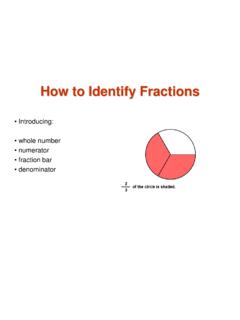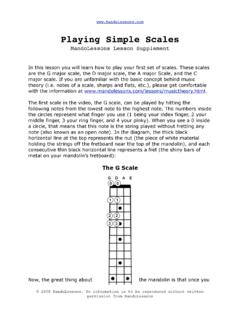Transcription of Music Theory For Flamenco - valdez.dumarsengraving.com
1 Music Theory For Flamenco by Flamenco Chuck Keyser E-Mail: Copyright Flamenco Chuck Keyser, 1998. Contents Basic Theory Modes and Scales The circle of Fifths Basic Chord Theory Keys Used for the Flamenco Guitar Keys associated with Flamenco Palos Question and Answer in Flamenco Harmony Major, Minor, and Phrygian Mode Keys Used for Flamenco Basic Phrygian Mode Chord Substitutions Secondary Dominants (Phrygian Mode). Secondary Dominants (Major and Minor Keys). Secondary Dominant Scales Accidentals and Complex Chords Diminished (7th) Chords in Flamenco Modulation Artistic Preferences Basic Theory The following is a brief introduction to Music Theory relevant to Flamenco .
2 Flamenco Music is organized according to interval relationships from the chromatic scale, which consists of all the notes possible for the guitar; the fundamental interval is the half step, which is the pitch distance ( high or low ) from one fret to another immediately above it on the guitar fingerboard. Another fundamental interval is the octave; this interval is the pitch distance obtained by dividing the length of the string(stopped at the nut and the bridge of the guitar) in half; on the 12th fret of the guitar, where the body of the guitar meets the neck on the traditional instrument ( , not cutaway). Relationships between notes of different octaves starting from the same note are the same, except higher or lower in pitch.
3 In particular, corresponding notes and chords within each of these octaves will have the same names. The guitar is normally tuned to a pitch of A=440 cps; the 5th fret of the open E string. However, for the Flamenco guitar all further discussion of Theory will be relative to the position of the capo (or cejilla); which functions as the new nut of the guitar. The strings are considered to be in open tuning (E, A, D, G, B, E) from this point. The octave is divided into 12 half steps, which correspond to the frets on the guitar within the octave. There are 12 possible starting points, each corresponding to a note in the chromatic scale , which consists of all possible notes on the guitar fretboard, organized in half steps.
4 The notes (pitches). are named from the letters of the alphabet from A to G; notes can be named from the note below by appending a # (sharp) or from the note above by a b (flat). For the present discussion, note there is no sharp or flat between B and C or between E and F. The natural scale consists of those notes without sharps or flats (A, B, C, D, E, F, G). Other scales within the octave can be defined by the interval relationships between their notes; chords, which are notes struck simultaneously or in sequence (arpeggios) can also be defined by their interval relationships. These will be discussed below. Music is further organized into keys; the relationships between chord and scales within a particular key are preserved from key to key.
5 These relationships are calculated based on the first note of the key, which is called the tonic. For example, the note A is the tonic of a scale in the key of A; the note Gb is the tonic of a scale in the key of Gb. A relationship that is carried over from one key to another is called a transposition; melodies or chord progressions are said to be transposed from one key to another if their relationships are maintained intact. Modes and Scales Within each key, modes form the foundations of the scales used in Flamenco . The modes are defined by the interval relationships from the natural scale, beginning on each note. The three modes used for Flamenco are the Ionian Mode (the Major Scale), the Aolean Mode (the Natural Minor Scale).
6 And the Phrygian Mode. The Phrygian Mode has the most characteristic Flamenco sound, and forms the basis of the Gypsy toques ( , Solea, Bulerias, Siguiriyas). The Ionian Mode is also called the Major Scale; the Aeolian mode is used as the basis for the Harmonic Minor Scale, in which the 7th note is raised a half step: The three scales primarily used in Flamenco , then, are the Major Scale, the Harmonic Minor Scale, and the Phrygian Mode. (The Melodic Minor Scale is also used occasionally used; it makes the interval jump from the 6th note to the 7th note less pronounced). The Keys used for the Flamenco Guitar are those which include most or all of the open strings of the guitar (relative to the capo); that is, E, A, D, G and B.
7 Within each key, the Major, Minor, and Phrygian Mode scales are related ( , use the same notes). We have already seen this in the above example, where C Major, A (Harmonic) Minor, and the E Phrygian Mode use (almost) the notes of the natural scale. In this case, A Minor is said to be the relative minor to C Major, and vice versa. Similarly, the E Phrygian Mode is said to be relative (or, more precisely, related) to A Minor and C Major. Notes can also be referenced by their numerical position in the scale (calculating from the tonic, starting on 1", using the letter names of the notes). The pitch distance (or interval) for the unison, 2nd, 4th, 5th, and octave is independent of the character (Major or Minor) of the scale and are called Perfect, while the 3rd, 6th, and 7th intervals are designated Major or Minor, depending on the scale.
8 Intervals half-step less than or greater than Major, Minor, or Perfect are called Diminished or Augmented, respectively. For chords, additional notes are often referenced by the octave above ( , a 2nd = 9th; 4th = 11th; 6th = 13th. These relationships are shown in the figure below, along with the number of steps that define each interval: There are powerful relationships between the major and minor scales which will be further developed in the section on chords and their progressions (harmony). (The Phrygian Mode also is related, but somewhat differently.). The circle of Fifths Keys and their associated scales can be arranged in a circle according to the number of sharps or flats they contain.)
9 Starting with the key of C Major (and its relatives; A Natural Minor, and E Phrygian Mode) at the top (no sharps or flats), the keys are arranged by 5ths in a clockwise direction, adding one sharp for each key, and in a counter-clockwise direction by adding flats. (Note that one goes in 4ths if traversing the circle in a counter-clockwise direction). One way to memorize not only the order of keys around the circle of fifths, but also the particular sharps or flats that are added for each of them is through the sentence Father Charles Goes Down And Ends Battle for the clockwise direction, and Battle Ends And Down Goes Charles' Father in the counter-clockwise direction.
10 The circle of Fifths is a convenient way of memorizing the various keys and scale structures, and will have further application as our discussion continues. It is especially effective in transposing harmonic and melodic sequences between keys. Basic Chord Theory Intervals can be used to define chords, which with their progressions form the basis of chording compas, and thus the foundation of Flamenco . A chord can be defined as three or more (different) notes struck simultaneously; the three notes are determned by their interval relationships. This basic chord of three notes is called a triad. Chords are defined according to the major or minor scale from their bottom note, or root.
